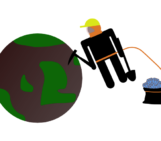
Apart from our own planet Earth, there are a lot of Peculiar Planets out there! In this series we take a look at a planetary body or system worthy of our geodynamic attention, and this week we are back to our own solar system, more precisely to our neighbour Mars. In this post, Robert Citron, PhD student at the University of California, Berkeley, writes about the links between oceans, shorelines, and volcanism on Mars. A David Bowie approved blog post!
Whether Mars was warm enough in its early history to support large oceans remains controversial. Although today Mars is extremely cold and dry, several lines of geological evidence suggest early Mars was periodically warm and wet. Evidence for ancient liquid water includes river channels, deltas and alluvial fans, lakes, and even shorelines of an extensive ocean.
Such features are carved into Mars’ ancient crust, which contains a remarkable geologic record spanning from over 4 billion years ago to present. How and where fluvial erosion takes place is highly dependent on topography. However, Mars is a dynamic planet and the topography observed today does not necessarily represent the planetary surface billions of years ago. Geological markers that seem misaligned today, such as river flow directions and sea levels, may be more consistent with ancient topography. Geodynamic models of how the planet has changed shape over time can therefore be used to test and constrain evidence of water on early Mars.
Shorelines are one example where geodynamic models have helped interpret the geological record. Perhaps the most compelling evidence for ancient Martian oceans are the hypothetical palaeo-shorelines that border Mars’ northern lowland basin. However, the shorelines fail to follow an equipotential surface, or contours of constant elevation, which would be expected if they formed via a standing body of liquid water. One explanation is that the shorelines used to follow an equipotential surface, but subsequent changes to the planet’s shape warped them to their present-day elevations, which vary by up to several kilometers.
Two geodynamic processes that likely changed the global shape of Mars are surface loading and true polar wander. True polar wander occurs when a planet reorients relative to its spin axis, which reshapes the planet because it changes the location of the equatorial bulge produced by the planet’s rotation. Large scale true polar wander on Mars was examined by Perron et al. (2007), which found that it could have warped past shoreline profiles to their present-day topographic profiles.
Another possibility is that Martian shoreline markers were deflected by flexure associated with surface loads. The emplacement or removal of material on a planet’s surface can cause flexure and displacement of nearby crust. This is observed on Earth, where melting of glaciers has unburdened underlying crust, allowing for rebound and displacement of past shoreline markers. Similar processes could be at work on Mars, but on a global scale.

Mars topography: The massive Tharsis volcanic province (red) is situated on the boundary between the southern highlands (orange) and northern lowlands (blue). The lowlands may have been covered by one or more ancient oceans, and are bordered by palaeo-shorelines. Two of the most prominent shorelines are the older Arabia shoreline (dashed line) and younger Deuteronilus shoreline (solid line). Image constructed by R. Citron using MOLA data. Shoreline data from Ivanov et al. (2017) and Perron et al. (2007).
The largest load on Mars is the Tharsis rise, a volcanic province that dominates the topography and gravity of the planet. Tharsis was built by volcanic activity over hundreds of millions to billions of years. Its emplacement changed Mars’ shape on a global scale; in addition to the Tharsis rise, there is a circum-Tharsis depression and an antipodal bulge.
In recent work (Citron et al. 2018), we found that the present-day variations in shoreline elevations can be explained by flexure from Tharsis and its associated loading. Of the two most prominent Mars shorelines, the older (~ 4 billion years old) Arabia shoreline corresponds to pre-Tharsis topography, deformed by almost all of the flexure associated with Tharsis. The younger (~ 3.6 billion years old) Deuteronilus shoreline corresponds to late-Tharsis topography, requiring only ~17% of Tharsis loading to explain its variations in elevation. This suggests that the Arabia shoreline formed before or during the early stages of Tharsis, and the Deuteronilus shoreline formed during the late stages of Tharsis growth. The match between the present-day shoreline markers and ancient equipotential surfaces supports the hypothesis that the markers do indicate shorelines formed by an ancient ocean.
The timing of ancient Martian oceans is consistent with recent work by Bouley et al. (2016), which found that the Mars valley networks (ancient river channels) also better fit Mars’ pre-Tharsis topography. In the topography of Mars prior to Tharsis, the flow direction of the channels are more consistent with the topographic gradient, and the channels occur at latitudes and elevations where climate models predict water ice (resulting in ice melt) to form.
The timing of the shorelines and valley networks relative to Tharsis volcanism suggests a close link between the stability of water on Mars and volcanic activity. Atmospheric models predict a cold and icy early Mars, however it is possible that oceans may be more sustainable during periods of heightened volcanism. Tharsis activity has also been associated with outflow channels indicative of catastrophic flooding that may have inundated the northern plains with water. Further examination of the link between Tharsis volcanism and oceans could increase our understanding of early Mars habitability.
Further reading: Bouley, S., Baratoux, D., Matsuyama, I., Forget, F., Séjourné, A., Turbet, M., & Costard, F. (2016). Late Tharsis formation and implications for early Mars. Nature, 531(7594), 344. Citron, R. I., Manga, M., & Hemingway, D. J. (2018). Timing of oceans on Mars from shoreline deformation. Nature, 555(7698), 643. Ivanov, M. A., Erkeling, G., Hiesinger, H., Bernhardt, H., & Reiss, D. (2017). Topography of the Deuteronilus contact on Mars: Evidence for an ancient water/mud ocean and long-wavelength topographic readjustments. Planetary and Space Science, 144, 49-70. Matsuyama, I., & Manga, M. (2010). Mars without the equilibrium rotational figure, Tharsis, and the remnant rotational figure. Journal of Geophysical Research: Planets, 115(E12). Perron, J. T., Mitrovica, J. X., Manga, M., Matsuyama, I., & Richards, M. A. (2007). Evidence for an ancient martian ocean in the topography of deformed shorelines. Nature, 447(7146), 840. Ramirez, R. M., & Craddock, R. A. (2018). The geological and climatological case for a warmer and wetter early Mars. Nature Geoscience, 11(4), 230.



